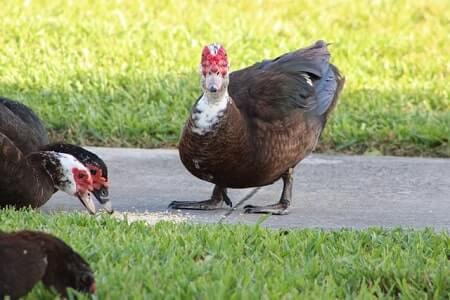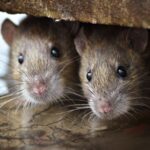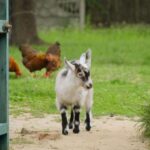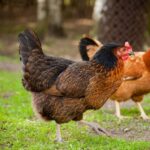I often see people on forums asking what breed or species the “duck that looks like a chicken” is.
I noticed that almost everyone is talking about the same duck - the Muscovy duck.
Muscovy ducks do look a little bit like a chicken. Not so much when you stand them side-by-side, but to the untrained eye or from a distance I don’t blame anyone for thinking it’s a chicken.
Table of Contents
What Are Muscovy Ducks?
Muscovy ducks are an interesting breed of duck. They are the only domesticated duck that is not derived from the Mallard, so they do have some different characteristics from other common breeds of duck.
Despite being one of the first duck breeds, they didn’t find their way over to the United States until the 20th century.
Since then, they’ve exploded in numbers due to being such a fun, social, and friendly breed to raise.
A couple of interesting things about Muscovies that make them great pets;
- They are very quiet for a duck, they don’t “quack” loudly
- They are social animals and enjoy being around humans and other animals
If you’re interested in adding to your backyard flock or owning ducks for the first time, I recommend checking out Muscovies.
Related - What you need to know about keeping Muscovies with chickens.
Why Do Muscovy Ducks Look Like Chickens?

Muscovies have caruncles on their faces, which is the “red stuff” that makes them look more like a chicken than a duck at first glance.
Now, obviously chickens do not have caruncles. But this is the feature a lot of people confuse with their red wattles and combs.
If you keep backyard chickens it’s easy to see the difference. But we have to remember that most people do not see chickens or ducks close up on a regular basis. So, I can understand why some people think these ducks are a breed of chicken.
They’re pretty plump too and are raised for their meat and eggs in some parts of the world.
Why Do Muscovy Ducks Have Red Faces?
There is no mistaking a Muscovy with their red faces. As I mentioned above, these growths are called caruncles, and they actually serve an important role.
Tiny holes that excrete oil are located across their caruncles. They rub this oil all over their feathers when they’re preening to keep their feathers nice and slick for the water.
This is very different from the function of a chicken’s wattle and comb. A chicken’s comb, in particular, helps them regulate their body temperature and is also an indication of their general health.
Want to Know More About Muscovies? Here Are Some Cool Facts
Here are some of the most interesting facts and characteristics of these unique looking ducks:
- They are very effective at foraging for insects and even small rodents - great pest control.
- Being social animals they are great companions for other animals.
- They have very sharp claws - be careful when handling.
- Males tend to be almost twice the size of females in most cases, and are usually more colorful.
- The name for a group of Muscovy ducks is either a flock, paddling, raft, or team.
- They wag their tails furiously when they are excited, defensive, or just happy to see someone.
- Muscovies can quack if needed, but they choose to be fairly quiet.
- They are great at flying, you’ll want to consider clipping their wings to keep them from fleeing.
- Muscovies are not born with red faces. It develops as they grow up and each duck has a different look.
- Adult males weigh around 10-15 lbs, and females weigh around 6-8 lbs.
Related - Want a bird that’s great for pest control? Learn about Guinea fowl here.
Differences Between Muscovy Ducks and Chickens

While some people think they look similar, there are loads of key differences between these two species of birds.
Whether you’re planning to raise them together or separately, here are some of the main differences:
Habitat
Muscovies are happiest exploring a wide area on foot, by air, and by swimming. They love to forage and eat all kinds of plants and insects and will make nests in hollow trees or overgrowth.
Domestic chickens on the other hand will not roam far from their coop. They do enjoy scratching around for food, but not to the extent of a Muscovies.
Maintenance
One of the main differences between ducks and chickens is that chickens do not like water as ducks do.
They do not swim on lakes, they do not bathe in water, and to be honest, they don’t even like being out in the rain for the most part.
If you’re raising Muscovies, ideally you’ll live near some water so they have somewhere to swim and clean themselves. If not, you’ll need to provide some water for them.
Chickens, on the other hand, take dust baths to clean themselves. They need a nice patch of loose dirt to roll around in. You can find out more about chicken dust baths here and the best types of sand to use to help them out.
Feeding
Baby Muscovy ducklings or mules as they’re called have different dietary needs from baby chicks. If you’re raising both as babies, you’ll need to feed them separate formulated feeds.
As they grow up, however, they can both eat a quality commercial chicken feed. Muscovies are much less reliant on feed though, given the space to roam they’ll find enough to eat while foraging.
In Summary
Now you know exactly what that duck is that “looks like a chicken”, it’s a Muscovy!
Hopefully, you found this introduction to these fun ducks interesting. If you’re in a position where you can raise some of these unique looking ducks, go for it!
Resources
Image credits - Photos by Christian Bartolone, Hortensia Carmona, and Jenny Hill on Unsplash




